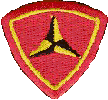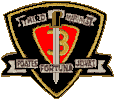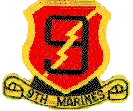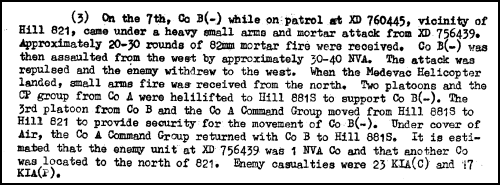



|
Known as the "Hill Fights" or "The First Battle of Khe Sanh", these battles took place between April 24 and June 7, 1967. The battle between the People's Army of Vietnam (PAVN or NVA) and United States Marines took place in the I Corps Tactical Zone, near the village of Khe Sanh. The fights were for Hill 881 North, Hill 881 South, and Hill 861. Khe Sanh was located near the Laotian border, south of the Demilitarized Zone (DMZ) between North and South Vietnam. As early as 1962, the U.S. Military Command, Vietnam (MACV) established an Army Special Forces camp near the village as the Americans wanted a military presence there to block the infiltration of enemy forces from Laos, to provide a base for launching patrols into Laos to monitor the Ho Chi Minh Trail, and to serve as a western anchor for defense along the DMZ. In 1966 the Marines built Khe Sanh Combat Base (KSCB) adjacent to the Army Special Forces camp, and organized their combat activities around named operations. By early 1967, the Marine position was reinforced to regimental strength. On April 20, Operation Prairie IV began, with heavy fighting between the Marines and NVA forces. The next marine operations were named Crockett and Ardmore. The Marines were monitoring the strategically vital Ho Chi Minh trail as it wound through the jungles in nearby Laos. Dominated by high hills on all sides, the combat base had to be screened on foot by the Marine infantrymen while crack, battle-hardened NVA units roamed at will through the high grass and set up heavy defenses on steep, sun-baked overlooks. The sequence of events and participating units in the Hill Fights were: April 24 - Bravo Company, 1st Battalion, 9th Marine Regiment patrol engages large enemy force north of Hill 861 and prematurely triggers attack on Khe Sanh. The "Hill Fights" begin. April 25 - 2nd Battalion, 3rd Marines (2/3) and 3rd Battalion, 3rd Marines (3/3) airlifted to KSCB to counter enemy drive. So was Kilo Company, 3rd Battalion, 9th Marines (Kilo 3/9). April 28 - After heavy preparation fires, Lt. Col. DeLong's 2nd Battalion, 3rd Marines (2/3) assaults and seizes Hill 861. Losses were heavy. April 29 - May 2 - Lt. Col. Wilder's 3rd Battalion, 3rd Marines (3/3) seizes Hill 881 South after 4 days of heavy fighting. That fighting included K Company, 3rd Battalion, 9th Marines. Kilo Company saw 14 men killed in action on April 30, 1967 as they tried to provide security and later relieve Mike Company, 3/3 Marines. May 3 - 2/3 repulses strong enemy counterattack south of Hill 881N. May 5 - 2/3 secures final objective, Hill 881N. May 11 - The "Hill Fights" terminate 940 NVA but the 3rd Marines lost 155 men killed in action May 13 - 3rd Marines shuttled to Dong Ha as the 26th Marines (Forward) and 1st Battalion, 26th Marines (1/26) move into Khe Sanh. Colonel Padley, Commanding Officer, 26th Marines (FWD), relieves Colonel Lanigan as the Senior officer present at Khe Sanh. Elements of 1/26 occupy combat base, Hills 881S, 861, and 950. Operation Prairie IV ends and Operation CROCKETT commences. May 21 & June 07 - 1st Battalion, 26th Marines lose 22 men killed in action on Hill 821 or near Hill 881 South. The 1/26 Marines' Command Chronology for June 1967 contains the following entry:

Full details of the entire battle for the 3/3 Marines can be found at Ray Stubbe's 3/3 Marines Khe Sanh Hill Fights of '67 web site. A Marine's Story on Hill 881 South is a story of one man's participation in the battle on the 30th of April 1967. Kenneth Flowers, Vinton, Virginia gives his accounting of events on that day. The battle for Kilo Company, 3rd Battalion, 9th Marines began early on April 30. At 0615H, they moved from their night defensive position to link up with M/3/3. The lead elements of Kilo Company linked up with the rear elements of the formation while the lead elements of M/3/3 started their attack on Hill 881 at 0800H. Hill 881-South consists of two high knolls with a saddle between, and several fingers sloping downward from the hill. Both peaks, strong-points of the NVA Battalion's defense, employed perimeter defenses with a line defense employed between the knolls (NVA estimated platoon size elements occupied these knolls). NVA Defensive positions also extended down the fingers to the northeast, north, and west. A very difficult task lay ahead for the Marines. The attack plan was for First Platoon, (Mike 3/3) to get to the top of Hill 881, then go right along the ridgeline, while the 3d Platoon would follow but turn left at the top. Their 2nd Platoon would provide a base of fire and reserve reinforcement to the lead platoons. As the Marines of Mike Company moved up the hills, they began to receive sporadic fire, but nothing that they could not handle, or so they thought. The 1st Platoon worked it's way up to the top and proceded eastward into heavy opposition. 2nd Platoon was sent to reinforce them, and after joining them, started to close with the enemy when they were hit again with heavy fire from a well dug-in enemy in heavily camouflaged positions and by sniper fire from individual riflemen located in trees. They received 30 rounds of incoming 82mm mortar and at this point, the platoons were trapped, unable to advance or withdraw. When the 2 platoons tried to come down the hill the same way they went up, the North Vietnamese opened up on them and they could not move. They had been lured into a death trap by an NVA perfect ambush. The battle was to last some 6 hours. Earlier that morning, KILO Company, 3/9, moved towards the base of Hill 881 South and formed a defensive 360. The squad leaders gathered and were told to stand-by to assist if there were any trouble. In about an hour, they began to realize the other platoons were in dire need of their help as they heard "all hell" break loose. About noon, K/3/9 proceeded up 881-South with the company 'on line', platoons in column. Their 2nd and 3rd Platoons went up the left side with the 1st Platoon moving up the right. 1st Platoon was soon pinned down, taking casualties from heavy fire and sniper fire. It was soon evident they had to withdraw from the bunker complex area they had entered. 2nd Platoon fought their way up the hill, taking devasting sniper fire on the way up and back down. On the way up, they began to receive heavy small arms and automatic rifle fire from 3 enemy bunkers located across a 50 meter wide clearing in a tree line. One of the squads silenced those 3 bunkers. Because they took so much fire coming up, the decision was made to gather their wounded and dead and go back down the hill, amid another barage of mortar fire. Third Platoon, Kilo, 3/9, moved up Hill 881-South through a ravine. The vegetation was thick at the bottom but thined near the top. They could see that the other platoons were pinned down by enemy fire but they had not yet received fire of any kind. They thought they hadn't been spotted yet. The platoon had underestimated the enemy. The NVA force was prepared and had lulled the unsuspecting 3rd Platoon into another trap amid the heavily fortified bunker complex - almost in the center of a 360 degree circle of bunkers. Fighting against heavy odds, they tried to gather as many of their dead and wounded and get off the hill. After taking more casualties, a laying down of sustained and heavy rocket and machine gun fire, and then a White Phosphorous smoke screen, they were able to extract themselves from the bunker complex and hill. All told, the fighting units had to leave 37 dead marines on top of the hill; trying to retrieve them then would have meant more loss of life. It was something the marines did not want to do but they had no choice under the circumstances. The Battalion (M/3/3, M/3/9, and K/3/9) finally disengaged from the heavy enemy contact and set up for the night. The evacuation of casualties was done by 2155 hours (almost 10 p.m.). Final casualty figures for the 881-South battle of 30 Apr were: 45 Marines killed, 109 wounded (90 were medevaced), 125 NVA confirmed killed (confirmed) and another probable 85. Most of the casualties were suffered by M/3/3, the initially engaged unit. The dead marines left on Hill 881 were recovered by 2100 hours (9 p.m.) on May 2 by the 3rd Battalion, 3rd Marine Regiment. The 161 Marines killed during the period 24 April and 7 June 1967 during their part of the "The Hills Fight" (Hill 881 South, Hill 881 North, Hill 861 and Hill 821) are: Companies E, F, G, H and H&S Company from the 3rd Marine Regiment lost men on April 30 and again on May 2nd and 3rd, 1967 on Hill 881 South, located west-northwest of Khe Sanh Airfield. They were:
On the 25th and 26th of April 1967, K Company lost 20 men on the Flank of Hill 861 (25th) approximately 5 Kilometers Northwest of the Khe Sanh Airfield and on Hill 861 itself (26th) approximately 5 Kilometers west-northwest of the Khe Sanh Airfield. They were:
On April 30 1967, M Company lost their men in heavy fighting on Hill 881 South, 8 Kilometers west-northwest of Khe Sanh Airfield. They were:
The U.S. Marines lost the following 27 men in the engagements on Hill 861, 7 Kilometers west-northwest of Khe Sanh Airfield on 24 April 1967.
Killed in action on May 21, 1967 in the vicinity of Hill 881 South, 9 Kilometers west-northwest of Khe Sanh Airfield.
The Operations Log for the 26th Marines on June 7, 1967 includes the notation that two of the 18 men killed were with an artillery Forward Observer team from A Battery, 1/13 Marines. Two of the four seriously wounded men died from their injuries. The 20 Americans - 19 Marines and 1 Navy Corpsman - who died as a result of the fight at Hill 821 were:
-- The Virtual Wall, September 9, 2014 |